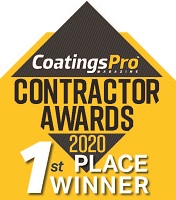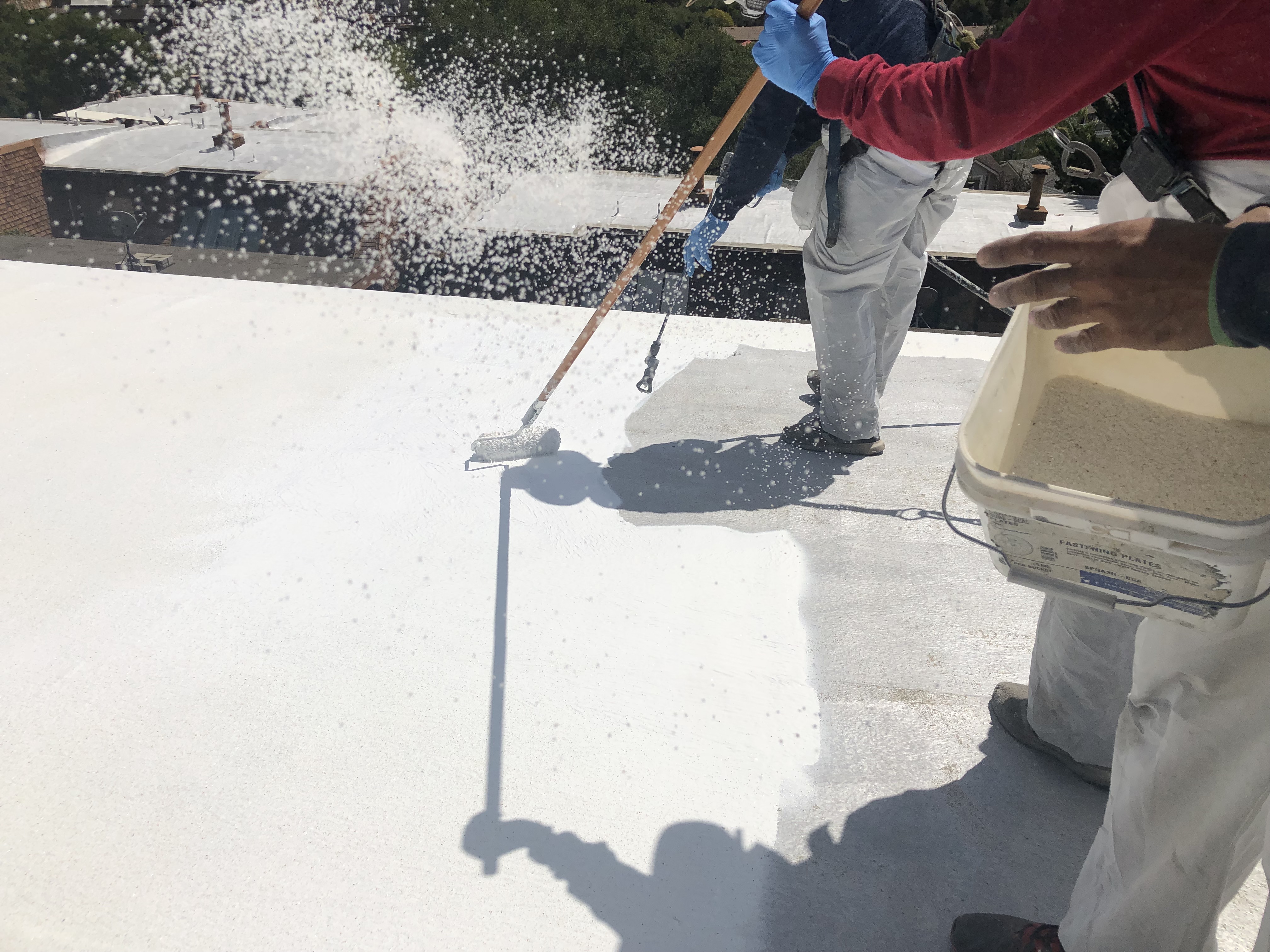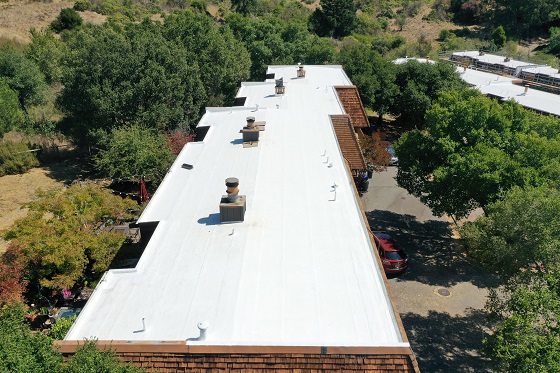There’s nothing like having firsthand knowledge of the roofing system’s (or systems’, in this case) history on a project. At least so says Gary Harvey, general manager of Wedge Roofing.
“San Francisco Bay Area’s Trusted Roofing Contractor” services Marin, Napa, San Francisco, and Sonoma Counties, and the company has been in business for 44 years. They know a thing or two about roofing, so when they say the building’s history matters, there’s reason to believe them.
Wedge Roofing’s involvement at Creekside Homes started in 1982 when they “conventionally” roofed nine multi-family residences with a built-up system and granular cap sheet. The project is located in Mill Valley, Calif. and sits on the western side of the San Francisco Bay next to the redwoods of Muir Woods National Monument (part of the U.S. National Park Service).
Over the years, Wedge Roofing continued to inspect the roofing system. And then in 1999, the company came back on board with another full itinerary. They worked with the client on a long-lasting strategy that would avoid another “horrendous disruption to their 24 high-end residential occupants.” That’s what the client experienced in the initial removal and replacement project, according to Wedge Roofing’s submission for CoatingsPro’s 2020 Contractor Awards Program. That 1999/2000 “application consisted of multiple layers of urethane coating, which yielded a significant 18 years of performance with very minimal service requirements,” the submission says.
Flip the calendar another 19 years to 2019. In the latest iteration of the Creekside Homes saga, Wedge Roofing returned with a new system to continue the rooftop solution. How did they intend to update the same project to last another 20 years? And why did the judges consider this to be an award-winning project? Read on to find out!
Digging Into the Details
 Submitted by Harvey, this project garnered the contracting company first place in CoatingsPro’s Commercial Roof category. The solution may seem straightforward on paper, but when you dig into the details, it’s clear that the application certainly presented its own set of challenges.
Submitted by Harvey, this project garnered the contracting company first place in CoatingsPro’s Commercial Roof category. The solution may seem straightforward on paper, but when you dig into the details, it’s clear that the application certainly presented its own set of challenges.
Over the course of seven days, the seven-person crew applied one layer of a commercial-grade silicone and embedded granules. Day one included two adhesion pull tests for each of the nine buildings. Those “yielded double digit, extremely solid results,” Harvey reported. The next step was to remove any debris or contaminants from the roofs, especially considering how close the site was to the freeway. The crew accomplished that task using Honda 6.5 hp power washers.
Another item that the crew had to battle throughout the project was moisture. San Francisco is known for its foggy, wet weather. Solutions included shifting the crew’s start times, extending work into the evening, and covering prepped surfaces with visqueen at the end of the day to ensure dryness for the coatings application the following day. “The key to a successful ‘low perm’ coating application is not to trap or embed moisture, and to this end, nothing was left to chance, no intrusive or surface moisture reading omitted,” the submission says.
When it came to the coating portion, the crew installed one layer of GE Enduris 3500 by Momentive. That was spray applied, back rolled, and embedded with Lucas #11 Fire White granules for traction. They used Graco 833 and 933 rigs with XTR-7 guns to achieve a total average dry film thickness (DFT), including the granules, of 15 mils (381.0 microns).
By increasing the DFT, the crew was able to embed the granules without having to come back with a second pass of the silicone. Wedge Roofing sees that additional 1 gallon (3.8 L) of material to embed the granules as negligible when compared to labor savings. The results of which included needing to access each roof only two times — to power wash and then apply the one layer of coatings — as well as lessening the length of the project by 20 percent and achieving an overall savings of almost $10,000.
In total, the buildings added up to 23,000 square feet (2,136.8 m2) for the crew to cover, and then, at the end of the project, to complete slit samples. Those were to ensure proper mil coverage.

Safety Centered
This project wouldn’t have been possible without the leadership of Fortino Salcedo Juarez, who started with Wedge Roofing in 1994. “Fortino’s dedication not only to his craft but also to Wedge Roofing is beyond compare,” the submission says. “His ability to participate in key decisions involving both work product and quality, and employee-related policies and procedures, is invaluable. With his bilingual language abilities, he is a vital bridge between English- and Spanish-speaking personnel. His ability to see the goal line and formulate a strategy to cross, it has been demonstrated more times than can be counted.”
This most “senior” employee is clearly a leader. In fact, Juarez began his tenure at Wedge Roofing on a tear-off and roofing demolition crew and currently leads the company’s low slope and coatings department as general superintendent. “Fortino exemplifies the notions of dependability, dedication, and a willingness to grow through continual education and opportunity — a true role model for others to follow,” the submission says.
Juarez holds Spray Polyurethane Foam Association (SPFA) credentials and is Occupational Safety and Health Administration (OSHA) 30-hour certified. Safety was top of mind for all of the crew members on this project.
The Wedge Roofing crew found the Cal OSHA guidelines to be “more challenging” than originally anticipated. “With the individual roof dimensions being too small to establish perimeter warning lines, the decision was made to have all personnel securely anchored and utilize full fall protection retractable cables and lanyards. It was apparent on day one each crew would have an additional person whose sole responsibility was to prevent entanglement and to ensure the safety line of one did not create trip or fall hazards for others,” according to the submission. Wedge Roofing was able to report no incidents or injuries from this project.
Future Impacts
Wedge Roofing has not only been involved with the longevity of this project (nearly 40 years’ worth!), but they’re also concerned with that of their local environment. They are a certified Green Roofing Contractor, representing sustainability efforts in the construction sector. “By incorporating recycling into our operation, we endeavor to do our part in preserving landfills, reducing waste, and protecting the environment,” the submission says. They also participate in several non-profits outside of the environmental impacts, including Rebuilding Together, Make-A-Wish Foundation, To Celebrate Life Breast Cancer Foundation, Alzheimer’s Association, and Can Do! Education Foundation.
Wedge Roofing is making impacts 24 hours a day, seven days a week. On this Creekside Homes project, hopefully those impacts last for another 20 years and beyond!
